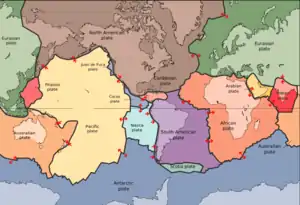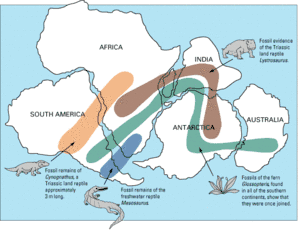Plate tectonics
Plate tectonics is a theory in geology that describes the surface crust of the Earth as being broken up into many large and small rigid "plates" floating on the mantle. They float because the siliceous material that makes up most of the crust is less dense than the mantle,[1] and can move around because the asthenosphere
| The poetry of reality Science |
| We must know. We will know. |
| A view from the shoulders of giants. |
v - t - e |

When plates collide mountain ranges are often thrust up, like the Himalayas or Andes. Where plates move apart new material from the mantle rises up to fill the gap, creating new crust that makes up mid-ocean ridges. The crust is returned back to the mantle in subduction zones like the Mariana Trench, where one plate sinks under another it is colliding with. Thus the planet's oceanic crust is continually "recycled" to and from the mantle. As a result oceanic crust tends to be relatively young - the oldest ocean crust is 200 to 300 million years old - while some continental crust is as old as 4 billion years. Where plates move laterally relative to one another, major earthquake faults develop. The San Andreas fault in California is one of the most famous of these.
Some volcanoes, like the Hawaiian archipelago, form when a plate slowly moves over a "hot spot" below it in the mantle. Because the hot spot melts through successive sections of the plate, this creates a chain of mountains that record the plate's history of motion. The "spot" in Hawaii is still "hot", resulting in active volcanoes on the newest island, and yet another island, Lōihi,
Continental drift
In 1912 the German polymath Alfred Wegener
Wegener's theory was widely rejected during his lifetime, not least because Wegener insisted on the aforementioned impossible mechanism. Geologists also avoided the evidence that Wegener did have, something now considered to have been a mistake.[4] It did not help that geologists saw Wegener, a professor of geophysics but a climatologist by profession, as an outsider trying to overturn all the established knowledge in their field.
However, in the 1950s and 1960s interest in continental drift was rekindled as geologists discovered several additional lines of evidence. Ocean floor mapping revealed a massive mountain range that encircles the world[5], and scientists studying magnetic anomalies and samples from ocean drilling found that new seafloor was being created along the mid-oceanic ridge. From then on, continental drift became incorporated into the theory of plate tectonics, which is now as fundamental to geology as evolution is to biology. Where Wegener suggested that the continents were blocks of crust plowing through the ocean floor, in plate tectonics the ocean crust acts more like a conveyor belt that drags the older and more stable continents around.
Researchers have since measured the rate of plate movement by using sophisticated positioning equipment placed along major fault lines, as well as by using satellite observations. As you might have guessed, the plates don't move very fast - about the same rate as your finger nails grow.
Pangaea
Pangaea is a "supercontinent" predicted, in a reverse fashion, by plate tectonics. At a point far back in time (ca. 250 million years ago), all of today's landmasses were conglomerated in one large feature. This had the result of allowing land animals to spread over the whole earth, including dinosaurs and mammals, and also produced a giant desert in the center of the continent.
Where supercontinents come from and go to
Supercontinents form in cycles; many before Pangaea are theorised to have existed and many possible future ones have also been predicted.
- As the ocean floor between the continents is subducted and disappears, continental plates move together to form supercontinents.
- They generally break up after a few hundred million years due to changes in mantle convection — the supercontinent acts as a cap and the mantle then overheats and wells up and splits the plate above. The Great Rift Valley
File:Wikipedia's W.svg in Africa is a current example of this process in action.
Useful predictions

Continental drift, and supercontinents such as Pangaea and Gondwana have turned out to be remarkably useful in matching patterns of fossils. The patterns of fossils on currently-separated continents turn out to make lots of sense if those continents were butted up next to each other at the age of the fossils.
Peleg
Some creationists think that the statement that the Earth divided in the days of Peleg, as described in Genesis 10:25, refers to Pangaea, and that the antedeluvian Earth had a single supercontinent, i.e. Pangaea. This is an uber-literal position: even Answers in Genesis thinks the statement refers to the Tower of Babel.[6] No, Answers in Genesis believes the pre-Flood Earth was the pre-Cambrian Rodinia,
Saturnism
In the peculiar Saturn Myth offshoot from Immanuel Velikovsky's planetary billiards scenario, it is claimed that, within human memory, Earth was a satellite of Saturn, orbiting in a tidal lock configuration so that the Pangea supercontinent always faced toward Saturn — which glowed as a brown dwarf star, thanks to the Electric Universe. Megafauna apparently flourish in this gravitational environment. Pangea was broken up when the Sun and/or Jupiter crashed into the Saturnian system and Earth ended up orbiting the Sun instead. This idea is nothing if not imaginative.
Alternative theories
Before evidence was gathered for the existence of tectonic plates and the mechanisms by which they move, there were a variety of other theories to explain how continents appeared, moved, changed, and disappeared.[8] Today, a few eccentric people still believe in them.
- Expanding Earth: Robert Mantovani suggested the world was expanding, pushing Africa and south America apart; the idea is still popular with some cranks
- Contracting Earth: James Dwight Dana suggested the earth cooled and wrinkled, forming mountain ranges
- Crust displacement: Charles Hapgood believed the earth could sometimes spin really fast, rearranging continents
- Poll-fleeing force (Polflucht
File:Wikipedia's W.svg ): Alfred Wegener's early theory of continental drift suggested that centrifugal force or some other mechanism would cause continents to move from the poles to the equator - Flat earth tectonics: some proponents of the flat earth thing believe there are tectonic plates below the flat earth, these plates collide producing mountain ranges, and hot rock rises from below to produce other mountains[9]
See also
References
- The crust forms when part of the mantle melts and rises to the surface, and this partial melting naturally creates rocks that are less dense than the material left behind.
- Despite the high temperatures in Earth's innards, the mantle is solid due to the tremendous pressures that the rocks there have to withstand (see here
File:Wikipedia's W.svg ). Like glacial ice, solid mantle rock can "flow" like a liquid over long time scales, but this "flow" (and plate motion) is at speeds of millimeters to a few centimeters per year. - Which is still an outstanding question in modern geology!
- However, overall, the delay in the success of the continental drift theory can be considered an object lesson in what happens when a scientist who happens to be right is a jerk about it.
- See the Wikipedia article on Marie Tharp.
- AIG:In the days of Peleg
- http://www.answersingenesis.org/articles/am/v3/n4/created-world
- See the Wikipedia article on Continental drift.
- Formation of Mountains and Volcanoes, Flat Earth Society wiki, accessed May 24, 2018